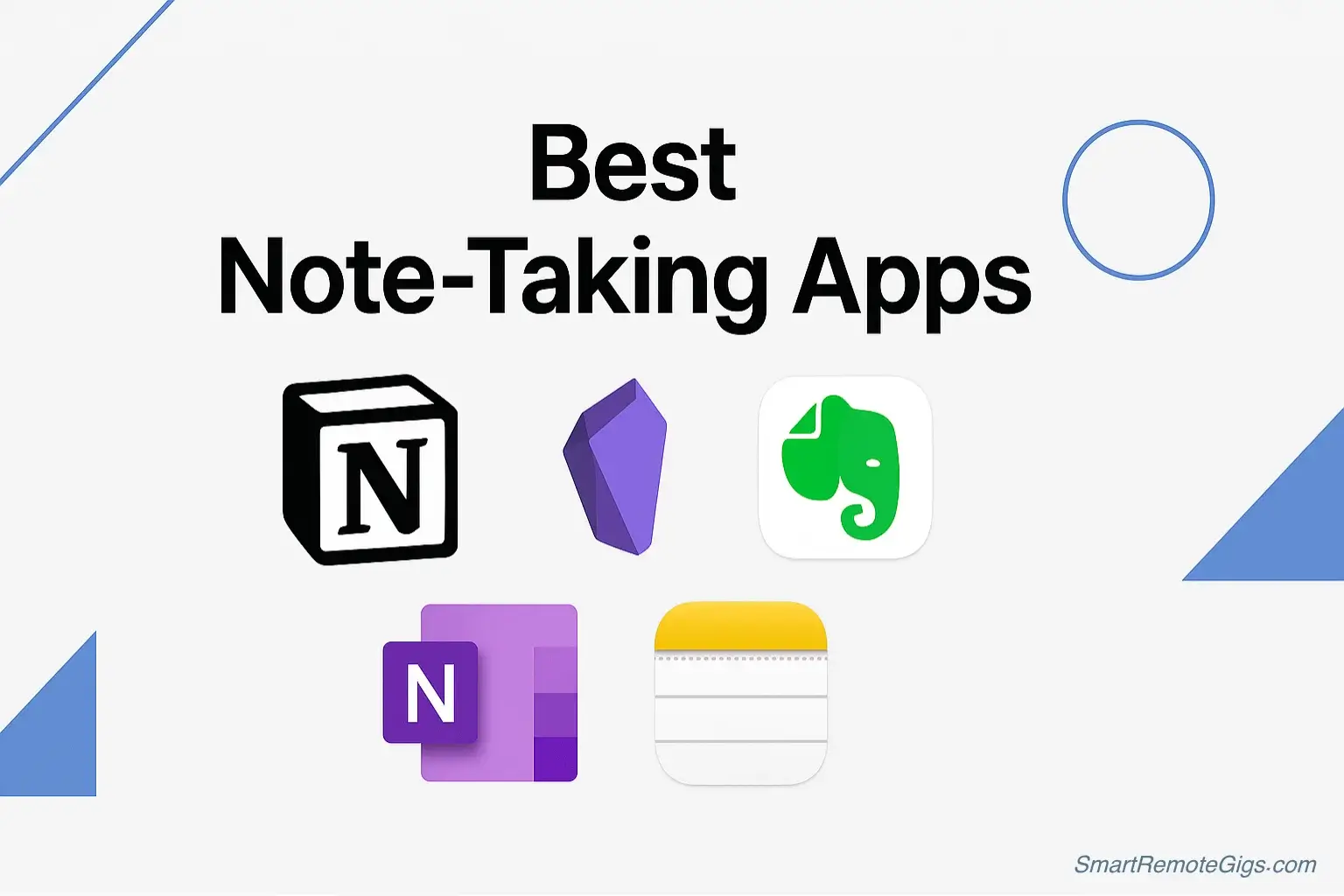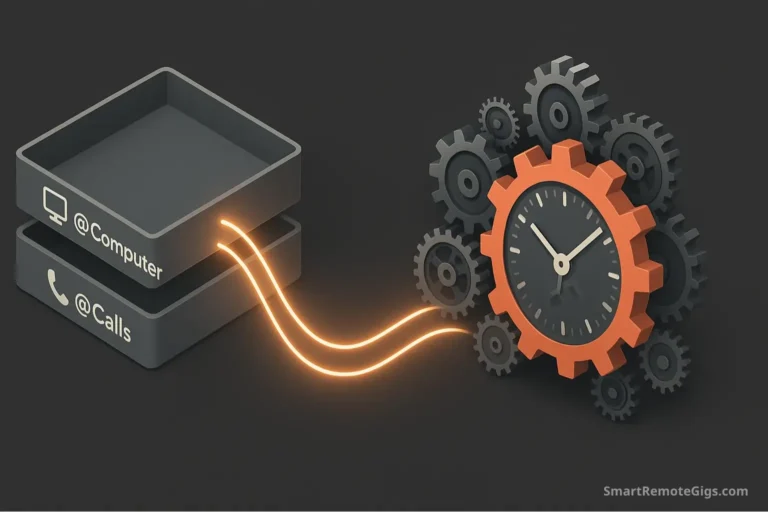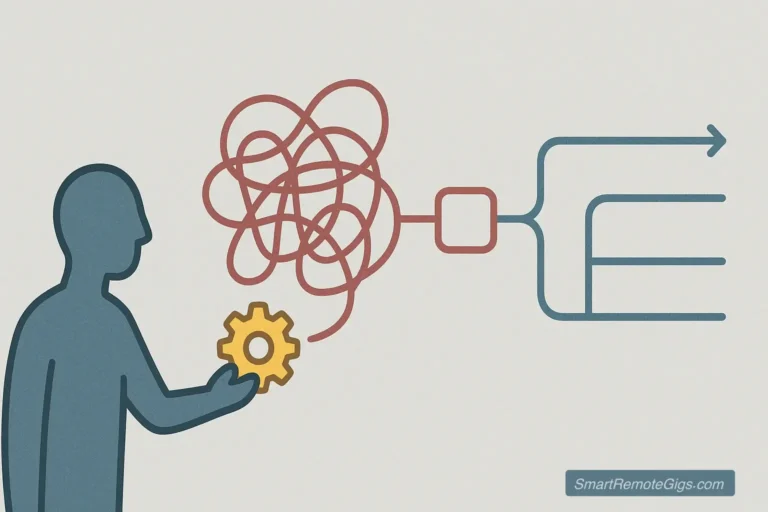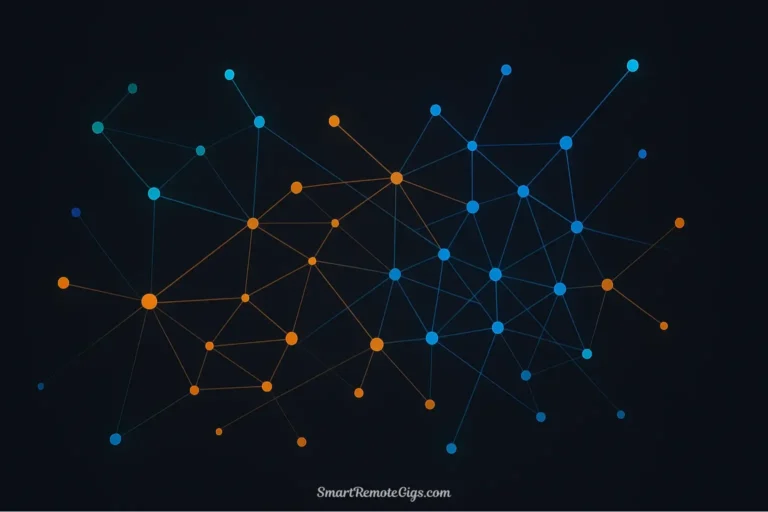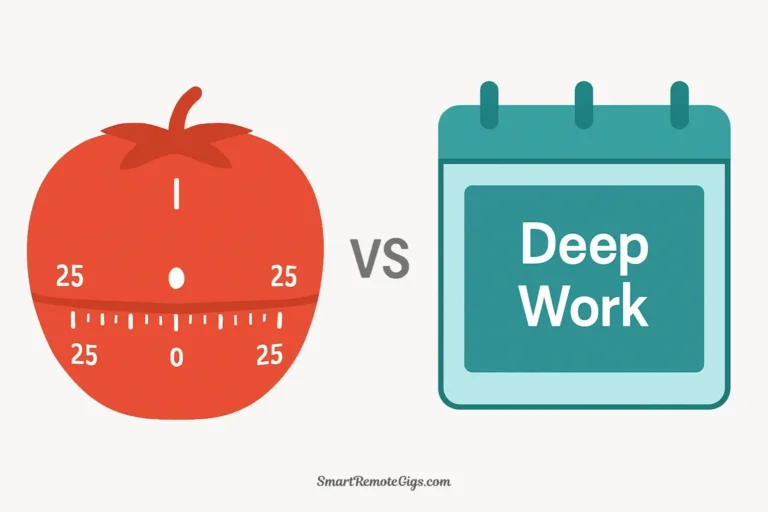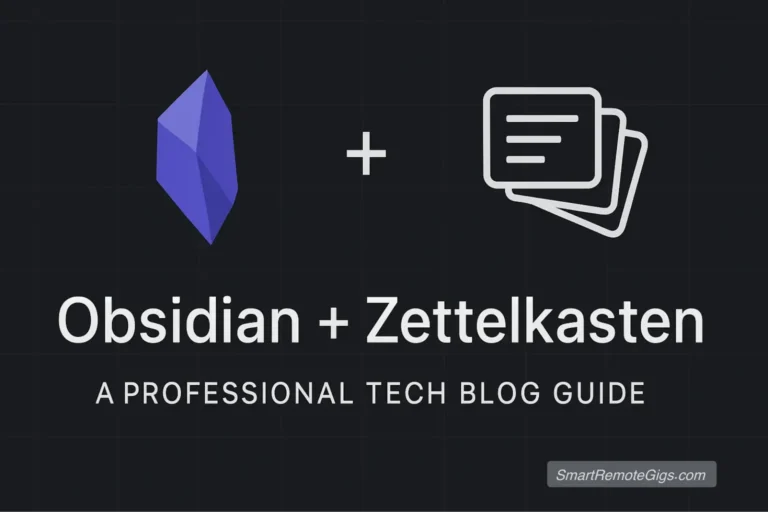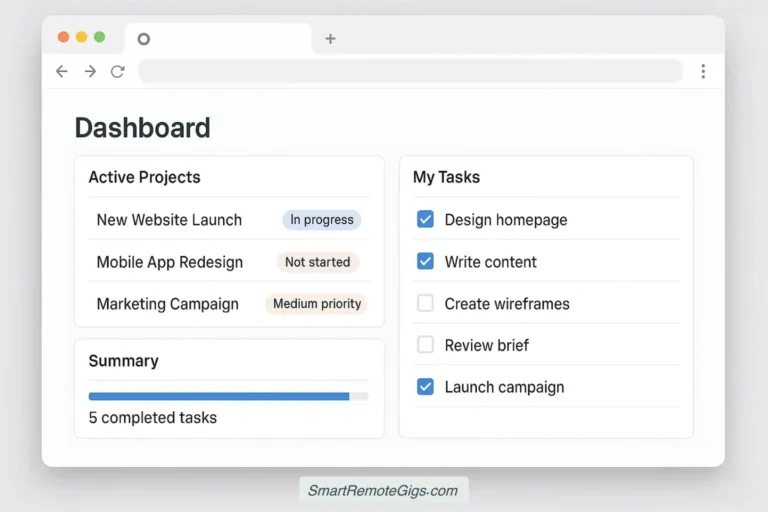The search for the perfect note-taking app is overwhelming. With dozens of options promising to revolutionize your productivity, how do you choose the right one? Unlike other generic lists, this guide is different—it’s a decision framework that cuts through the noise.
We’ve tested over 25 of the best note-taking apps available in 2025, evaluating everything from simple text editors to complex knowledge management systems. But here’s the key: the universal “best” app is a myth. The perfect digital notebook depends entirely on your unique workflow and needs.
This guide is a decision framework. We’ll help you first discover your “note-taking persona,” then match you to the ideal application. Whether you’re a student cramming for exams, a team leader managing projects, or a creative professional capturing fleeting ideas, we’ll guide you from app paralysis to a confident decision.
This guide is a decision framework. We’ll help you first discover your “note-taking persona,” then match you to the ideal application. But choosing the right tool is only the first step. To truly unlock your potential, it’s essential to understand the principles behind modern knowledge management, a concept we explore in our How to Build a Second Brain: A Step-by-Step Starter Guide. Whether you’re a student cramming for exams, a team leader managing projects, or a creative professional capturing fleeting ideas, we’ll guide you from app paralysis to a confident decision.
Before You Choose: What’s Your Note-Taking Persona?
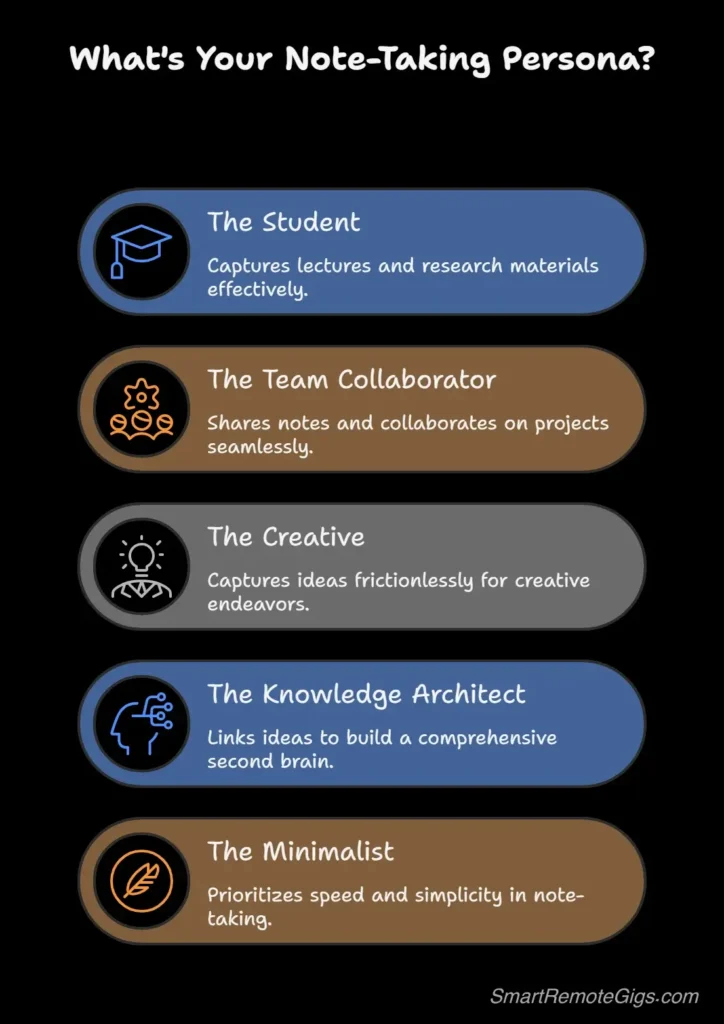
Before diving into our best note taking apps recommendations, take a moment to identify your primary use case. Understanding your persona will dramatically narrow down your options and save you hours of trial and error.
Are you a Student focused on research?
You need: Quick lecture capture, research organization, and revision tools.
Key features: Fast typing, audio recording, PDF annotation, and cross-device sync.
Best matches: OneNote, Notion, or Apple Notes.
Are you a Team Collaborator managing projects?
You need: Real-time sharing, meeting notes, and project documentation.
Key features: Collaborative editing, comments, task management, and team workspaces.
Best matches: Notion, OneNote, or Google Keep for simple sharing.
Notion is particularly powerful for this role; our step-by-step guide shows you exactly how to Build a Notion Project Management Dashboard (+ Free Template) to get your team organized.
Are you a Creative Brain-Dumper capturing ideas?
You need: Friction-free idea capture and flexible organization.
Key features: Quick capture, multimedia support, and intuitive categorization.
Best matches: Apple Notes, Google Keep, or Bear.
Are you a Knowledge Architect building a “second brain”?
You need: Connected thinking, linking ideas, and building a personal knowledge system.
Key features: Bidirectional linking, graph views, and powerful search.
Best matches: Obsidian, Logseq, or advanced Notion setups.
Are you a Minimalist seeking simplicity?
You need: Speed, simplicity, and distraction-free writing.
Key features: Clean interface, fast startup, and essential features only.
Best matches: Bear, SimpleNote, or Apple Notes.
Our Top Picks: The Best Note-Taking Apps at a Glance
Note: Ratings reflect how well each app fulfills its intended purpose, not as a direct comparison against others.
| App | Best For | Our Rating | Pricing |
|---|---|---|---|
| Notion | Team Collaborators, Knowledge Architects | ⭐⭐⭐⭐⭐ | Free tier available, $8/month paid |
| Obsidian | Knowledge Architects, Power Users | ⭐⭐⭐⭐⭐ | Free (Personal); Optional Sync ($8/mo) |
| Evernote | Digital Filers, Document Storage | ⭐⭐⭐⭐ | Free (Limited); Premium ($12.99/mo) |
| Apple Notes | Apple Users, Simplicity | ⭐⭐⭐⭐ | Completely free |
| OneNote | Microsoft Users, Students | ⭐⭐⭐⭐ | Free with Microsoft account |
| Google Keep | Quick Capture, Android Users | ⭐⭐⭐ | Completely free |
| Bear | Markdown Writers, Design Lovers | ⭐⭐⭐⭐ | Free tier, $1.49/month Pro |
The 7 Best Note-Taking Apps (In-Depth Reviews)
Notion: Best All-in-One Workspace
At-a-Glance:
- Pricing: Free for personal use, $8/month per user for teams
- Platforms: Web, Windows, Mac, iOS, Android
- Key Feature: Database-powered pages with infinite customization
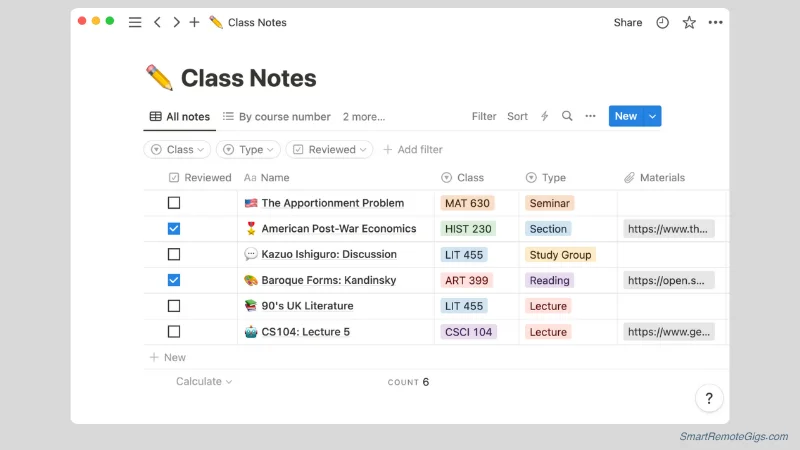
The Verdict: Notion has evolved into the Swiss Army knife of note taking software. It’s perfect for Team Collaborators who need project management alongside their notes, and Knowledge Architects who want to build comprehensive information systems. The learning curve is steep, but the payoff is enormous—a topic we explore fully in our In-Depth Notion Review for 2025: Is It Still the King?.
Pros:
Cons:
Real User Feedback: Reddit user u/ProductivityGuru shares: “Switched from Evernote to Notion last year. Yes, it took weeks to set up properly, but now my entire life runs through it—meeting notes, project tracking, personal goals. Game changer for team workflows, and you can see how it stacks up against its classic rival in our Notion vs. Evernote Showdown.”
Obsidian: Best for Your “Second Brain”
At-a-Glance:
- Pricing: Free for personal use, $50/year for commercial use
- Platforms: Windows, Mac, Linux, iOS, Android
- Key Feature: Bidirectional linking with interactive graph view
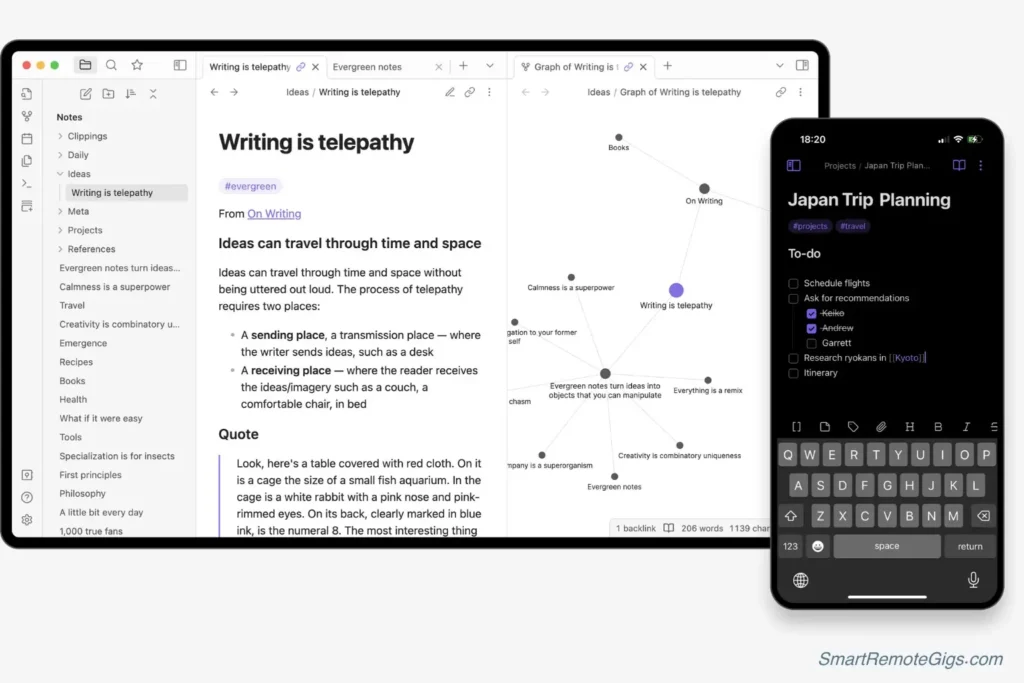
The Verdict: Obsidian is the gold standard for Knowledge Architects building a personal knowledge management system. Its powerful linking supports advanced methodologies, a process we detail in our Zettelkasten in Obsidian: A Step-by-Step Beginner’s Guide.
Pros:
Cons:
Real User Feedback: Twitter user @ResearcherLife notes: “6 months into Obsidian and I can’t imagine going back. The way it connects my research notes, book highlights, and random thoughts is incredible. Finally found my second brain.”
For a complete walkthrough on building your own ‘second brain’ from scratch, see our Ultimate Obsidian Review. To understand its core differences from Notion, explore our detailed Obsidian vs. Notion Comparison.
Evernote: Best for Digital Filing & Organization
At-a-Glance:
- Pricing: Free tier (limited), $7.99/month Premium, $9.99/month Professional
- Platforms: Web, Windows, Mac, iOS, Android
- Key Feature: OCR text recognition in images and PDFs
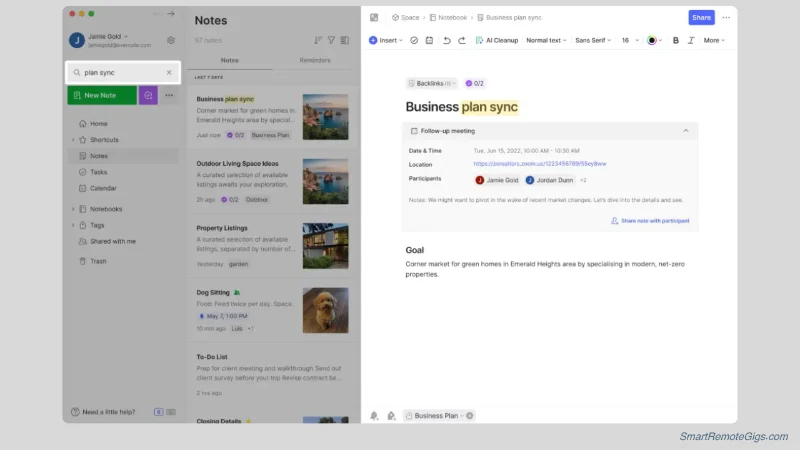
The Verdict: The original digital filing cabinet, Evernote remains unbeatable for users who need to capture and organize large volumes of diverse content. While it lost shine due to past performance issues, recent updates under new ownership have refocused the app on its core strengths: unparalleled capture and search capabilities that make it ideal for research-heavy workflows.
Pros:
Cons:
Real User Feedback: Long-time user @DigitalNomadLife shares: “Evernote isn’t sexy anymore, but after 8 years and 10,000+ notes, nothing beats it for finding that random receipt or article I saved months ago. The search is unmatched.”
Curious about Evernote’s recent improvements? Our comprehensive Evernote Review in 2025: A Comeback Story is now live. Thinking of switching? Our Evernote to Notion Migration Guide walks you through the process step-by-step.
Apple Notes: Best Free App for Apple Users
At-a-Glance:
- Pricing: Completely free
- Platforms: Mac, iOS, iPadOS, Web (iCloud.com)
- Key Feature: Seamless Apple ecosystem integration

The Verdict: Don’t underestimate Apple Notes. This free note taking app has quietly become one of the most capable options available, especially for Creative Brain-Dumpers and Minimalists in the Apple ecosystem. Recent updates have added powerful features while maintaining simplicity.
Pros:
Cons:
Real User Feedback: iPhone user @CreativeWriter notes: “Switched from expensive apps back to Apple Notes. The speed and simplicity are perfect for my creative process. Quick Note from Control Center is a game-changer.”
Want to see how it compares to Google’s offering? Our Apple Notes vs. Google Keep Showdown breaks down the differences.
OneNote: Best for Microsoft Ecosystem Users
At-a-Glance:
- Pricing: Free with Microsoft account
- Platforms: Windows, Mac, iOS, Android, Web
- Key Feature: Free-form canvas with infinite page space
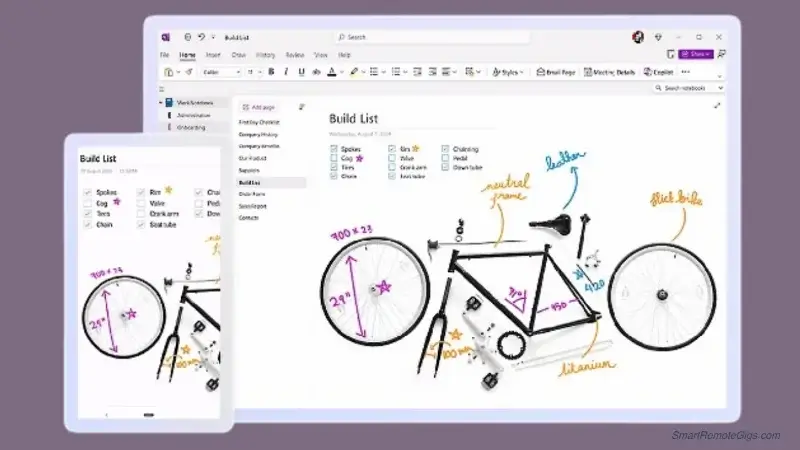
The Verdict: Microsoft’s OneNote excels as a digital notebook app for Students and Team Collaborators already using Microsoft 365. Its free-form canvas approach mimics physical notebooks while offering powerful digital features. For academic use cases, our OneNote vs. Notion for Students guide provides a detailed breakdown.
Pros:
Cons:
Google Keep: Best Free App for Simplicity
At-a-Glance:
- Pricing: Completely free
- Platforms: Web, Android, iOS
- Key Feature: Visual note cards with color coding
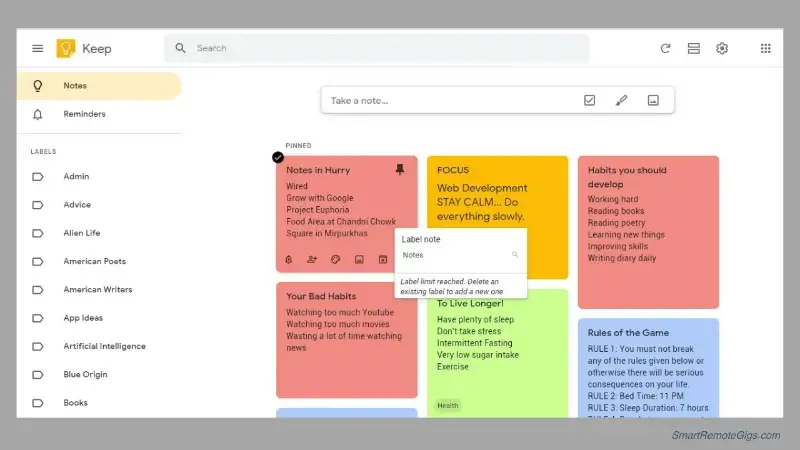
The Verdict: Google Keep proves that sometimes less is more. Perfect for Creative Brain-Dumpers and Minimalists who need quick capture without complexity. While it lacks advanced features, its simplicity and visual approach make it incredibly effective for basic note-taking needs.
Pros:
Cons:
Real User Feedback: Android user @MinimalistWriter shares: “Google Keep’s visual approach changed how I think about notes. Color-coding my ideas and seeing everything at a glance is so much better than scrolling through endless text files.”
Our detailed Google Keep vs. Apple Notes: Which Free App Wins? comparison helps you choose between the two best free options available.
Bear: Best for Markdown & Design
At-a-Glance:
- Pricing: Free tier available, $1.49/month for Bear Pro
- Platforms: Mac, iOS, iPadOS
- Key Feature: Beautiful markdown editor with tag-based organization
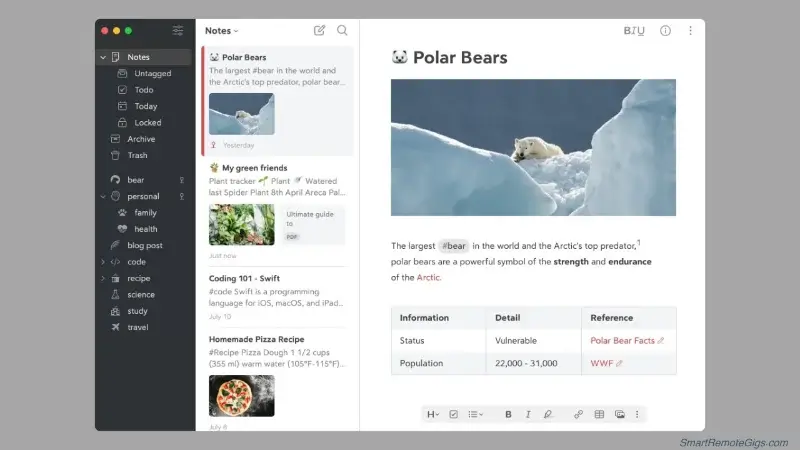
The Verdict: Bear is the most beautiful note taking app you’ll ever use. Designed specifically for Markdown Writers and Design Lovers, it combines aesthetic appeal with powerful writing tools. It’s a deliberately personal workspace, however, as it lacks any collaboration features. The tag-based organization system is both simple and sophisticated, making it perfect for individual creative work. For writers choosing between premium Apple apps, our Bear vs. Ulysses for Writers comparison examines both tools in detail.
Pros:
Cons:
Real User Feedback: Writer @MarkdownMaster notes: “Bear’s design is so clean it makes writing feel like meditation. The tag system is genius—way more flexible than folders, and the search is lightning fast.”
Honorable Mentions: Other Great Apps We Tested
Logseq: Open-source, block-based note-taking with bidirectional linking. Perfect for privacy-conscious users wanting Obsidian-like features with complete data ownership.
Craft: Beautiful, block-based writing app for Apple users. Excellent for structured documents and creative projects with its card-based interface.
Amplenote: Combines note-taking with task management and calendar integration. Great for users who want GTD-style productivity features built-in.
SimpleNote: Ultra-minimalist, cross-platform note-taking with just text and tags. Perfect for users who want distraction-free writing across all devices.
Roam Research: The original bidirectional linking app that inspired Obsidian. Still powerful for research and knowledge work, though with a steeper learning curve.
Joplin: Open-source alternative to Evernote with end-to-end encryption. Excellent for privacy-conscious users who want traditional note organization.
How We Test & Our Review Criteria
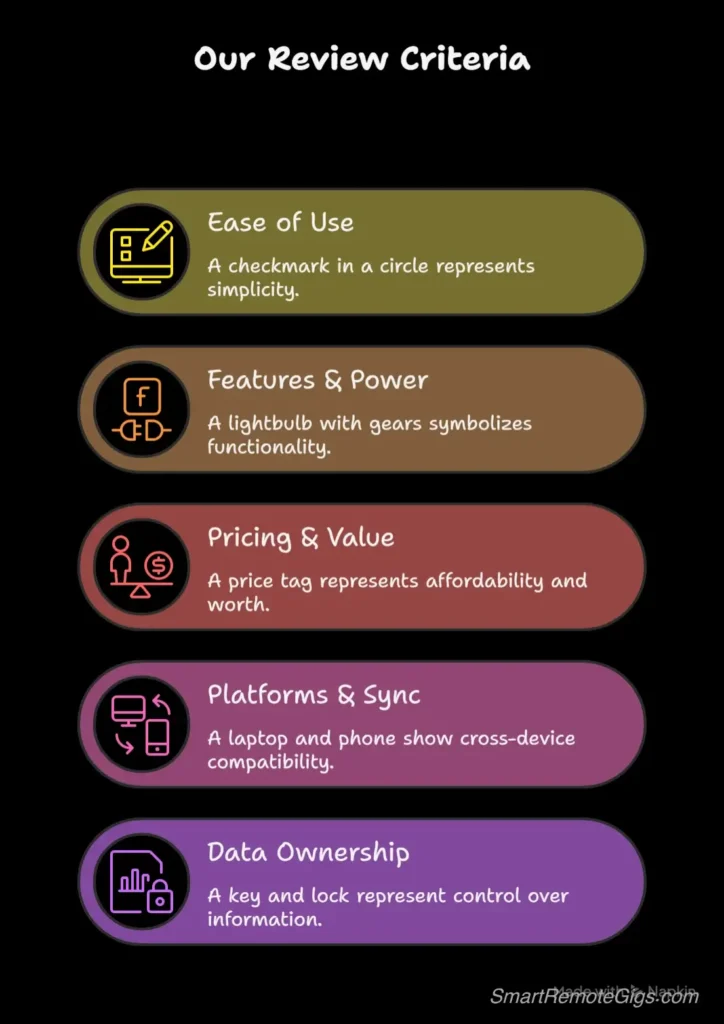
To ensure our best note taking apps recommendations are reliable and comprehensive, we evaluate each app across five key criteria: Ease of Use & Interface, Features & Power, Pricing & Value, Platform Availability & Sync, and Data Ownership & Privacy.
Ease of Use & Interface: How steep is the learning curve? Can new users get productive quickly, or does it require extensive setup and training?
Features & Power: Does it handle linking, collaboration, attachments, and multimedia? How well does it scale from simple notes to complex knowledge systems?
Pricing & Value: Is the free tier genuinely usable, or just a teaser? Do paid plans offer fair value for the features provided?
Platform Availability & Sync: How well does it work across devices? Is the mobile experience comparable to desktop, and does sync work reliably?
Data Ownership & Privacy: Can you export your data easily? Are notes stored locally or in the cloud? What are the privacy implications?
Each app is tested with real-world scenarios across multiple devices and use cases. We prioritize long-term usability over flashy features that don’t add practical value.
Frequently Asked Questions (FAQ)
What is the most secure note-taking app?
Obsidian and Joplin offer the best security through local storage and encryption options. Apple Notes is also secure within the Apple ecosystem with end-to-end encryption enabled.
Which app is best for students taking lecture notes?
OneNote and Notion excel for students. OneNote’s free-form canvas is perfect for mixed content (text, diagrams, audio), while Notion’s database features help organize research and assignments.
Can I switch from Evernote to Notion easily?
Yes, both apps offer import tools, though some formatting may be lost. Our comprehensive Evernote to Notion Migration Guide provides step-by-step instructions and tips for preserving your data structure during the move.
Is Obsidian really free?
Yes, Obsidian is completely free for personal use. You only pay for commercial use ($50/year) or optional sync services ($8/month).
What’s the best free note-taking app?
Apple Notes for Apple users and Google Keep for Android users offer the best free experiences. OneNote is also excellent and completely free across all platforms.
Which app has the best handwriting support?
Apple Notes on iPad offers superior handwriting recognition and Apple Pencil integration. OneNote also provides good handwriting support across multiple platforms.
The Final Verdict: There Is No “Best”—Only What’s Best for You
After testing dozens of note taking apps and digital notebook solutions, one truth emerges: the perfect app depends entirely on your persona, workflow, and ecosystem preferences. However, the tool is only half the equation; a powerful organizational philosophy is just as crucial. Many users find success applying a universal system like the one we detail in our guide to The P.A.R.A. Method: A Complete Guide with Examples.
- For Students: Choose OneNote for free-form flexibility or Notion for advanced organization and project management.
- For Team Collaborators: Notion dominates with its all-in-one workspace approach, while OneNote excels for Microsoft-centric teams.
- For Creative Brain-Dumpers: Apple Notes (iOS) or Google Keep (Android) provide friction-free capture, while Bear offers beautiful writing experiences.
- For Knowledge Architects: Obsidian is unmatched for building connected knowledge systems, with Logseq as an open-source alternative.
- For Minimalists: Apple Notes, Google Keep, or Bear provide clean, distraction-free environments focused on pure writing.
The best note taking tools are the ones you’ll actually use consistently. Start with your persona, try the free tiers of our top recommendations, and don’t be afraid to switch if your needs evolve. Your perfect note taking software is out there—this guide just helps you find it faster.
This is a living guide. What’s your favorite app? Did we miss anything important? Leave a comment below—we read and reply to every one, and your feedback helps us keep this resource current and comprehensive for the entire community.
The 7 Best Note-Taking Apps of 2025
Notion
The Swiss Army knife of note-taking software, perfect for Team Collaborators and Knowledge Architects who want to build comprehensive information systems.
Real User Feedback: 'Switched from Evernote to Notion... now my entire life runs through it—meeting notes, project tracking, personal goals. Game changer.'
Editor’s Rating:
Price: Free
Visit WebsiteObsidian
The gold standard for Knowledge Architects building a personal knowledge management system. It offers unparalleled flexibility and data ownership with local files.
Real User Feedback: '6 months into Obsidian and I can’t imagine going back. The way it connects my research notes, book highlights, and random thoughts is incredible.'
Editor’s Rating:
Price: Free
Visit WebsiteEvernote
The original digital filing cabinet, Evernote remains unbeatable for users who need to capture and organize large volumes of diverse content with powerful search.
Real User Feedback: 'Evernote isn’t sexy anymore, but after 8 years and 10,000+ notes, nothing beats it for finding that random receipt or article.'
Editor’s Rating:
Price: Free
Visit WebsiteApple Notes
A surprisingly capable free app for Creative Brain-Dumpers and Minimalists in the Apple ecosystem, offering powerful features with simplicity.
Real User Feedback: 'Switched from expensive apps back to Apple Notes. The speed and simplicity are perfect for my creative process. Quick Note is a game-changer.'
Editor’s Rating:
Price: Free
Visit WebsiteOneNote
Excels as a digital notebook for Students and Team Collaborators in the Microsoft 365 ecosystem, with a free-form canvas that mimics physical notebooks.
Users appreciate its free-form canvas and excellent integration with the Microsoft 365 suite for a seamless workflow.
Editor’s Rating:
Price: Free
Visit WebsiteGoogle Keep
Perfect for Creative Brain-Dumpers and Minimalists who need quick capture without complexity. Its simplicity and visual approach are highly effective for basic notes.
Real User Feedback: 'Google Keep’s visual approach changed how I think about notes. Color-coding my ideas and seeing everything at a glance is so much better.'
Editor’s Rating:
Price: Free
Visit WebsiteBear
The most beautiful note-taking app, designed for Markdown Writers and Design Lovers. It combines aesthetic appeal with powerful writing tools for a personal workspace.
Real User Feedback: 'Bear’s design is so clean it makes writing feel like meditation. The tag system is genius—way more flexible than folders.'
Editor’s Rating:
Price: Free
Visit Website